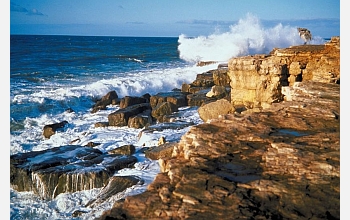
The release of sulfur and nitrogen into the atmosphere by power plants and agricultural activities–commonly referred to as acid rain–plays a minor role in making the ocean more acidic on a global scale, but the impact is greatly amplified in the shallower waters of the coastal oceans, according to new research.
The most heavily affected areas tend to be downwind of power plants (particularly coal-fired plants) and predominantly on the eastern edges of North America, Europe, and south and east of Asia.
The findings were published this week in the online edition of the journal Proceedings of the National Academy of Sciences.
Ocean acidification occurs when chemical compounds such as carbon dioxide, sulfur or nitrogen mix with seawater, a process which lowers the pH and reduces the storage of carbon. It hampers the ability of marine organisms–such as sea urchins, corals and certain types of plankton–to harness calcium carbonate for making hard outer shells or exoskeletons. These organisms provide essential food and habitat to other species, so their demise could affect entire ocean ecosystems.
“Acid rain isn’t just a problem of the land; it’s also affecting the ocean,” said Scott Doney, lead author of the study and a scientist at the Woods Hole Oceanographic Institution (WHOI) in Woods Hole, Mass. “That effect is most pronounced near the coasts, which are already some of the most heavily affected and vulnerable parts of the ocean due to pollution, overfishing and climate change.”
In addition to acidification, excess nitrogen input from the atmosphere likely promotes the overgrowth of phytoplankton and other marine plants that have caused more frequent harmful algal blooms and eutrophication (including the creation of oxygen-depleted dead zones) in the oceans.
“This analysis provides strong evidence that carbon dioxide is the culprit globally, even though locally, contamination by strong acids may be primarily responsible for increasing seawater acidity,” said Donald Rice, director of the National Science Foundation (NSF)’s Chemical Oceanography Program, which co-funded the research with NASA and NOAA.
The research team compiled and analyzed many publicly available data sets on fossil fuel emissions, agricultural runoff and other atmospheric emissions. The scientists built theoretical and computational models of the ocean and atmosphere to simulate where nitrogen and sulfur emissions were likely to have the most impact. They also compared their model results with field observations made by other researchers in the coastal waters around the United States.
Farming, livestock husbandry and the combustion of fossil fuels cause excess sulfur dioxide, ammonia and nitrogen oxides to be released to the atmosphere, where they are transformed into nitric acid and sulfuric acid. Though much of that acid is deposited on land (since it does not remain in the air for long), some of it can be carried in the air to the coastal ocean.
This rain of chemicals changes the chemistry of seawater, with the increase in acidic compounds lowering the pH of the water while reducing the capacity of the upper ocean to store carbon.
Seawater is slightly basic (pH between 7.5 and 8.4), but the ocean surface is already 0.1 pH units lower than it was before the Industrial Revolution. Previous research by Doney and others suggests that the ocean will become another 0.3 to 0.4 pH units lower by the end of the century, which translates into a 100 to 150 percent increase in acidity.
Doney collaborated on the project with Natalie Mahowald, Jean-Francois Lamarque, and Phil Rasch of the National Center for Atmospheric Research, Richard Feely of the Pacific Marine Environmental Laboratory, Fred Mackenzie of the University of Hawaii, and Ivan Lima of WHOI.